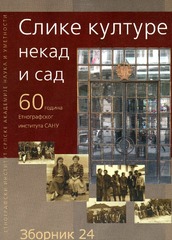Приказ основних података о документу
Време празника
Holiday Time
| dc.creator | Ивановић-Баришић, Милина | |
| dc.date.accessioned | 2020-05-14T13:48:58Z | |
| dc.date.available | 2020-05-14T13:48:58Z | |
| dc.date.issued | 2008 | |
| dc.identifier.isbn | 978-86-7587-045-6 | |
| dc.identifier.uri | https://dais.sanu.ac.rs/123456789/7512 | |
| dc.identifier.uri | https://dais.sanu.ac.rs/123456789/8697 | |
| dc.description.abstract | У раду је реч о празницима као o једној од битних одредница друштвеног живота. Износе се запажања о основним претпоставкама које су утицале на њихово опстајање, без обзира на то какав је тип друштва у питању. Празници који су обележили период друге половине 20. века, разлози њиховог настанка, али и неки од чинилаца који су утицали на престанак њиховог одржавања, такође представљају предмет овога рада. | sr |
| dc.description.abstract | Holidays represent an important part of the human culture. During the course of their long history, holidays were always related to crisis or critical moments of any society. One of the main rules of the holiday behavior is that they allow liberation from the usual, everyday rules of behavior, which are in total or partially suspended from the collective life. The former socialist society had several phases: 1. domination of traditional holidays (calendar cycle), 2. new holidays founded by the socialist government, 3. cessation of certain holidays introduced in the after-war period, 4. re-foundation of so-called traditional holidays and marginalization of holidays proclaimed by the former Yugoslavia, 5. re-domination of the so-called traditional holidays and establishment of the new state holidays. In the after-the war period, the state officials had to establish an alternative model of holiday celebration that would replace the marginalized holidays of the old celebration calendar. The May Day, March 8 th , Youth Day, but also other significant historical dates, like New Year, are mostly connected with urban areas; the newly established holidays were a good alternative to the traditional holidays. Rural areas experienced these changes differently though. The traditional holidays, at least in the first after-the war decades, were difficult to replace, so they continued to be celebrated in the subsequent decades with an inevitable adjustments to new life conditions. | en |
| dc.language.iso | sr | sr |
| dc.publisher | Београд : Етнографски институт САНУ / Belgrade : Institute of Ethnography SASA | sr |
| dc.relation | info:eu-repo/grantAgreement/MESTD/MPN2006-2010/147020/RS// | sr |
| dc.rights | openAccess | sr |
| dc.rights.uri | https://creativecommons.org/licenses/by-nc-nd/4.0/ | |
| dc.source | Слике културе некад и сад / Images of Culture Then and Now | sr |
| dc.subject | празници | sr |
| dc.subject | традиционални празници | sr |
| dc.subject | социјалистички празници | sr |
| dc.subject | друга половина 20. века | sr |
| dc.subject | holidays | sr |
| dc.subject | traditional holidays | sr |
| dc.subject | socialist holidays | sr |
| dc.subject | second half of the 20 th century | sr |
| dc.title | Време празника | sr |
| dc.title | Holiday Time | sr |
| dc.type | bookPart | sr |
| dc.rights.license | BY-NC-ND | sr |
| dc.rights.holder | Етнографски институт САНУ | sr |
| dc.citation.spage | 257 | |
| dc.citation.epage | 268 | |
| dc.description.other | Зборник радова Етнографског института САНУ 24 / Collection of Papers of the Institute of Ethnography SASA 24. Зборник поводом обележавања 60 година Етнографског института САНУ. | sr |
| dc.type.version | publishedVersion | sr |
| dc.identifier.fulltext | https://dais.sanu.ac.rs/bitstream/id/33126/bitstream_33126.pdf | |
| dc.identifier.rcub | https://hdl.handle.net/21.15107/rcub_dais_8697 |

